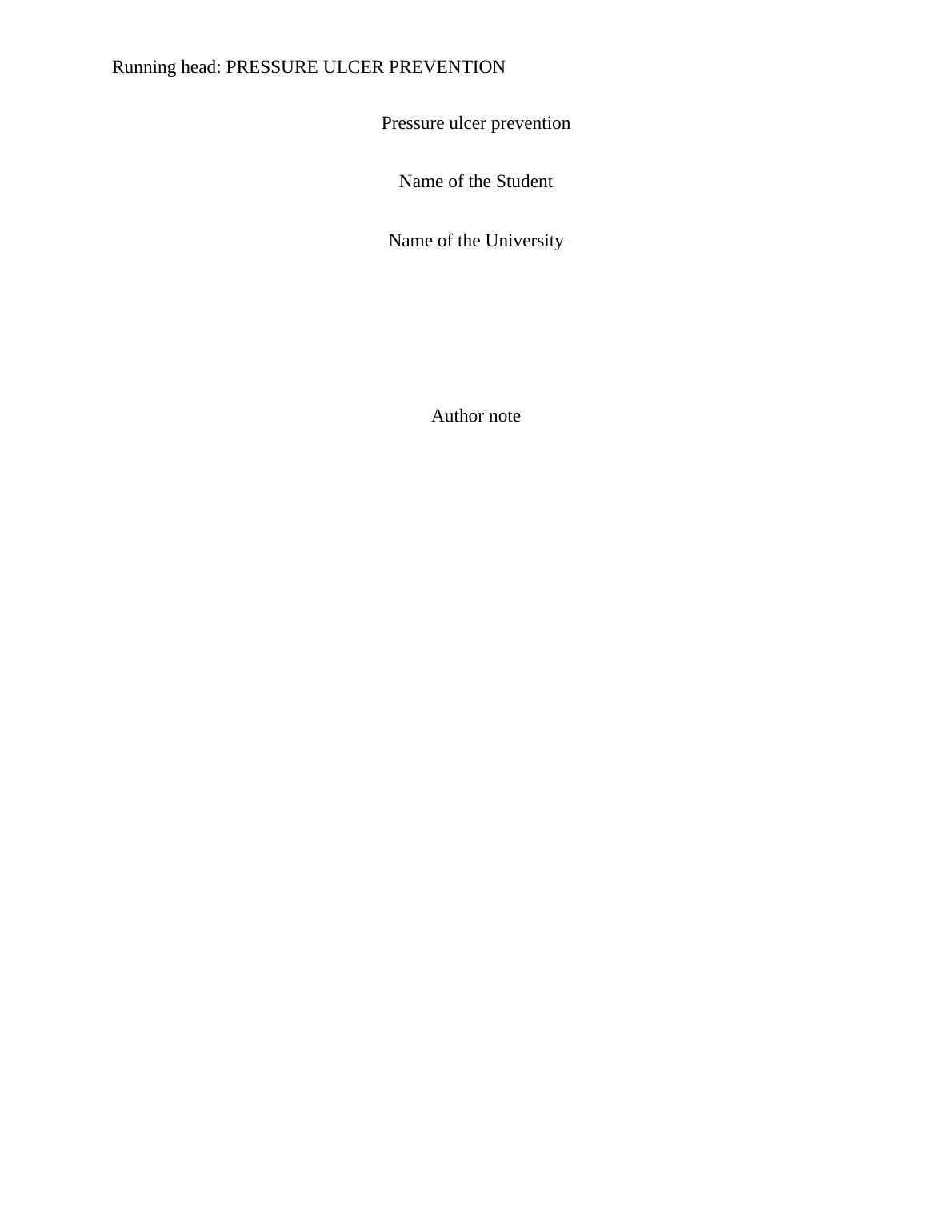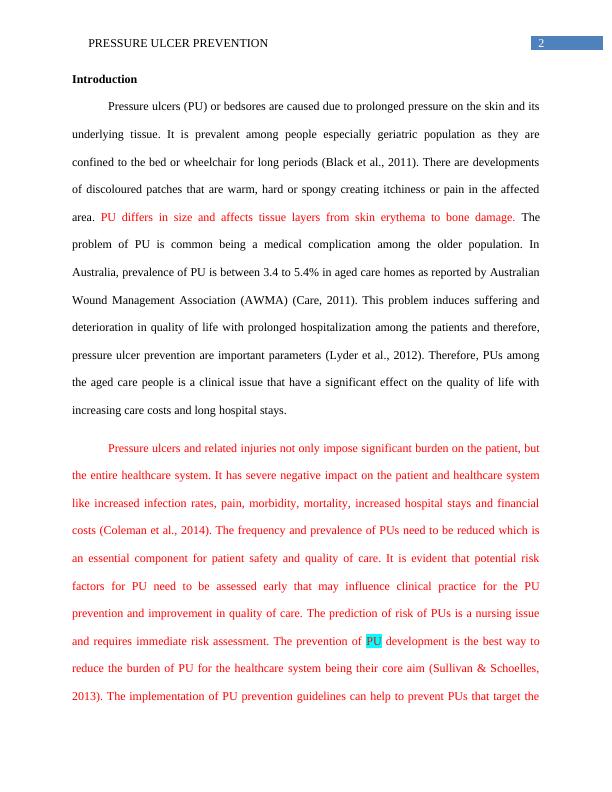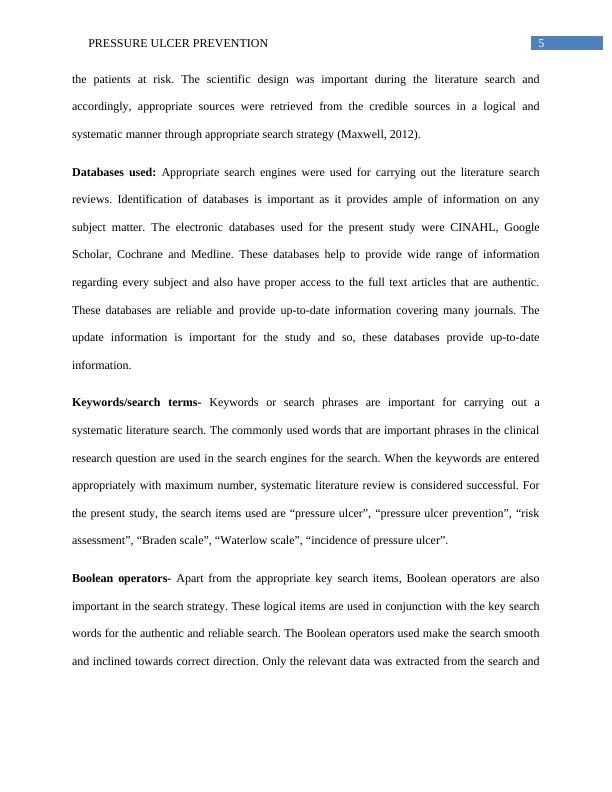Assessment of Pressure Ulcer Prevention
29 Pages9113 Words45 Views
Added on 2020-05-11
Assessment of Pressure Ulcer Prevention
Added on 2020-05-11
ShareRelated Documents
Running head: PRESSURE ULCER PREVENTION
Pressure ulcer prevention
Name of the Student
Name of the University
Author note
Pressure ulcer prevention
Name of the Student
Name of the University
Author note

1PRESSURE ULCER PREVENTION
Table of Contents
Introduction......................................................................................................................................2
Clinical question..............................................................................................................................4
Systematic search strategy...............................................................................................................4
Critical appraisal and summary of study findings:..........................................................................7
Implementation of evidence into nursing practice.........................................................................11
Conclusion.....................................................................................................................................15
References......................................................................................................................................17
Appendix........................................................................................................................................23
Table of Contents
Introduction......................................................................................................................................2
Clinical question..............................................................................................................................4
Systematic search strategy...............................................................................................................4
Critical appraisal and summary of study findings:..........................................................................7
Implementation of evidence into nursing practice.........................................................................11
Conclusion.....................................................................................................................................15
References......................................................................................................................................17
Appendix........................................................................................................................................23

2PRESSURE ULCER PREVENTION
Introduction
Pressure ulcers (PU) or bedsores are caused due to prolonged pressure on the skin and its
underlying tissue. It is prevalent among people especially geriatric population as they are
confined to the bed or wheelchair for long periods (Black et al., 2011). There are developments
of discoloured patches that are warm, hard or spongy creating itchiness or pain in the affected
area. PU differs in size and affects tissue layers from skin erythema to bone damage. The
problem of PU is common being a medical complication among the older population. In
Australia, prevalence of PU is between 3.4 to 5.4% in aged care homes as reported by Australian
Wound Management Association (AWMA) (Care, 2011). This problem induces suffering and
deterioration in quality of life with prolonged hospitalization among the patients and therefore,
pressure ulcer prevention are important parameters (Lyder et al., 2012). Therefore, PUs among
the aged care people is a clinical issue that have a significant effect on the quality of life with
increasing care costs and long hospital stays.
Pressure ulcers and related injuries not only impose significant burden on the patient, but
the entire healthcare system. It has severe negative impact on the patient and healthcare system
like increased infection rates, pain, morbidity, mortality, increased hospital stays and financial
costs (Coleman et al., 2014). The frequency and prevalence of PUs need to be reduced which is
an essential component for patient safety and quality of care. It is evident that potential risk
factors for PU need to be assessed early that may influence clinical practice for the PU
prevention and improvement in quality of care. The prediction of risk of PUs is a nursing issue
and requires immediate risk assessment. The prevention of PU development is the best way to
reduce the burden of PU for the healthcare system being their core aim (Sullivan & Schoelles,
2013). The implementation of PU prevention guidelines can help to prevent PUs that target the
Introduction
Pressure ulcers (PU) or bedsores are caused due to prolonged pressure on the skin and its
underlying tissue. It is prevalent among people especially geriatric population as they are
confined to the bed or wheelchair for long periods (Black et al., 2011). There are developments
of discoloured patches that are warm, hard or spongy creating itchiness or pain in the affected
area. PU differs in size and affects tissue layers from skin erythema to bone damage. The
problem of PU is common being a medical complication among the older population. In
Australia, prevalence of PU is between 3.4 to 5.4% in aged care homes as reported by Australian
Wound Management Association (AWMA) (Care, 2011). This problem induces suffering and
deterioration in quality of life with prolonged hospitalization among the patients and therefore,
pressure ulcer prevention are important parameters (Lyder et al., 2012). Therefore, PUs among
the aged care people is a clinical issue that have a significant effect on the quality of life with
increasing care costs and long hospital stays.
Pressure ulcers and related injuries not only impose significant burden on the patient, but
the entire healthcare system. It has severe negative impact on the patient and healthcare system
like increased infection rates, pain, morbidity, mortality, increased hospital stays and financial
costs (Coleman et al., 2014). The frequency and prevalence of PUs need to be reduced which is
an essential component for patient safety and quality of care. It is evident that potential risk
factors for PU need to be assessed early that may influence clinical practice for the PU
prevention and improvement in quality of care. The prediction of risk of PUs is a nursing issue
and requires immediate risk assessment. The prevention of PU development is the best way to
reduce the burden of PU for the healthcare system being their core aim (Sullivan & Schoelles,
2013). The implementation of PU prevention guidelines can help to prevent PUs that target the

3PRESSURE ULCER PREVENTION
risk factors related to PU development (Moore and Cowman, 2014). Concisely, the
understanding and identification of risk factors in the PU development can aid in developing
prevention interventions and better utilization of resources in clinical practice.
According to Coleman et al., (2013) three main factors contribute to PU development:
perfusion alterations, mobility/activity and skin status. For the assessment of these risk factors,
PU risk assessment tools are important component for the identification of patients at risk of
developing PU. The checklist comprises of Braden Scale, Waterlow Scale and Norton Scale that
are currently in use. These tools are valid, reliable, specific and sensitive by identifying the
individuals at risk in a consistent manner. However, there is little information available regarding
the reliability and validity of these tools and that acts as big challenge for the clinical setting.
Evidence also suggests that specificity and sensitivity of risk assessment tools vary in different
healthcare settings because of clinical judgment made on obtained risk assessment results
(García-Fernández et al., 2014).
According to Šáteková & Žiaková, (2014) among the most frequently used PU risk
assessment scales, Braden scale demonstrated optimal predictive validity. However, there is a
need to examine other scales in respective clinical settings and comparison with foreign studies.
On the other hand, another study conducted by Ang, Chang & Tay, (2014) showed that Braden
scale showed moderate predictive validity with low predictive specificity for PU risk assessment.
Therefore, further development and testing of risk assessment scales is important for
identification of PU risk factors and prevention.
From the above discussion, it is clear that risk assessment is important at the time of
admission and at periodic time intervals. According to Centres for Disease Control and
risk factors related to PU development (Moore and Cowman, 2014). Concisely, the
understanding and identification of risk factors in the PU development can aid in developing
prevention interventions and better utilization of resources in clinical practice.
According to Coleman et al., (2013) three main factors contribute to PU development:
perfusion alterations, mobility/activity and skin status. For the assessment of these risk factors,
PU risk assessment tools are important component for the identification of patients at risk of
developing PU. The checklist comprises of Braden Scale, Waterlow Scale and Norton Scale that
are currently in use. These tools are valid, reliable, specific and sensitive by identifying the
individuals at risk in a consistent manner. However, there is little information available regarding
the reliability and validity of these tools and that acts as big challenge for the clinical setting.
Evidence also suggests that specificity and sensitivity of risk assessment tools vary in different
healthcare settings because of clinical judgment made on obtained risk assessment results
(García-Fernández et al., 2014).
According to Šáteková & Žiaková, (2014) among the most frequently used PU risk
assessment scales, Braden scale demonstrated optimal predictive validity. However, there is a
need to examine other scales in respective clinical settings and comparison with foreign studies.
On the other hand, another study conducted by Ang, Chang & Tay, (2014) showed that Braden
scale showed moderate predictive validity with low predictive specificity for PU risk assessment.
Therefore, further development and testing of risk assessment scales is important for
identification of PU risk factors and prevention.
From the above discussion, it is clear that risk assessment is important at the time of
admission and at periodic time intervals. According to Centres for Disease Control and

4PRESSURE ULCER PREVENTION
Prevention (CDC), the healthcare professionals use these risk assessment tools being the best and
effective approach for PU prevention (Centres for Disease Control and Prevention, 2012).
Various tools are used for the risk assessment like Braden, Norton and Waterlow scale PU
assessment help healthcare professionals to identify individuals who might develop PU.
Therefore, the aim of this paper is to evaluate the effectiveness of Braden scale and Waterlow
scale for the assessment of PUs through systematic search strategy, identification of barriers and
strategies to implement the evidence in the clinical setting of Saudi Arabia.
Clinical question
In patients at risk for pressure ulcers, does Braden scale as compared to Waterlow
scale prevent the incidence of pressure ulcers?
Systematic search strategy
Methodology: For the alignment of the research question with the aim of the research that is
proposed, a systematic literature review is beneficial. The current trends of PU prevention in
different clinical settings are to be analysed based upon strong evidence and gather the best
evidence from the systematic literature review. This method is aimed at identification, evaluation
and summarization of the major findings so that best available information can be retrieved and
help to draw the evidences into practice (Liamputtong & Serry, 2013). Relevant literature can be
extracted from the vast pool of evidences and helpful in drawing conclusion for the
implementation into practice. The summarization of the key findings and identification of the
literature gaps along with future scope for research are the main aims of systematic literature
strategy. For the present study, a systemic literature strategy was carried out for understanding
the effectiveness of Braden scale as compared to Waterlow scale in the prevention of PUs among
Prevention (CDC), the healthcare professionals use these risk assessment tools being the best and
effective approach for PU prevention (Centres for Disease Control and Prevention, 2012).
Various tools are used for the risk assessment like Braden, Norton and Waterlow scale PU
assessment help healthcare professionals to identify individuals who might develop PU.
Therefore, the aim of this paper is to evaluate the effectiveness of Braden scale and Waterlow
scale for the assessment of PUs through systematic search strategy, identification of barriers and
strategies to implement the evidence in the clinical setting of Saudi Arabia.
Clinical question
In patients at risk for pressure ulcers, does Braden scale as compared to Waterlow
scale prevent the incidence of pressure ulcers?
Systematic search strategy
Methodology: For the alignment of the research question with the aim of the research that is
proposed, a systematic literature review is beneficial. The current trends of PU prevention in
different clinical settings are to be analysed based upon strong evidence and gather the best
evidence from the systematic literature review. This method is aimed at identification, evaluation
and summarization of the major findings so that best available information can be retrieved and
help to draw the evidences into practice (Liamputtong & Serry, 2013). Relevant literature can be
extracted from the vast pool of evidences and helpful in drawing conclusion for the
implementation into practice. The summarization of the key findings and identification of the
literature gaps along with future scope for research are the main aims of systematic literature
strategy. For the present study, a systemic literature strategy was carried out for understanding
the effectiveness of Braden scale as compared to Waterlow scale in the prevention of PUs among

5PRESSURE ULCER PREVENTION
the patients at risk. The scientific design was important during the literature search and
accordingly, appropriate sources were retrieved from the credible sources in a logical and
systematic manner through appropriate search strategy (Maxwell, 2012).
Databases used: Appropriate search engines were used for carrying out the literature search
reviews. Identification of databases is important as it provides ample of information on any
subject matter. The electronic databases used for the present study were CINAHL, Google
Scholar, Cochrane and Medline. These databases help to provide wide range of information
regarding every subject and also have proper access to the full text articles that are authentic.
These databases are reliable and provide up-to-date information covering many journals. The
update information is important for the study and so, these databases provide up-to-date
information.
Keywords/search terms- Keywords or search phrases are important for carrying out a
systematic literature search. The commonly used words that are important phrases in the clinical
research question are used in the search engines for the search. When the keywords are entered
appropriately with maximum number, systematic literature review is considered successful. For
the present study, the search items used are “pressure ulcer”, “pressure ulcer prevention”, “risk
assessment”, “Braden scale”, “Waterlow scale”, “incidence of pressure ulcer”.
Boolean operators- Apart from the appropriate key search items, Boolean operators are also
important in the search strategy. These logical items are used in conjunction with the key search
words for the authentic and reliable search. The Boolean operators used make the search smooth
and inclined towards correct direction. Only the relevant data was extracted from the search and
the patients at risk. The scientific design was important during the literature search and
accordingly, appropriate sources were retrieved from the credible sources in a logical and
systematic manner through appropriate search strategy (Maxwell, 2012).
Databases used: Appropriate search engines were used for carrying out the literature search
reviews. Identification of databases is important as it provides ample of information on any
subject matter. The electronic databases used for the present study were CINAHL, Google
Scholar, Cochrane and Medline. These databases help to provide wide range of information
regarding every subject and also have proper access to the full text articles that are authentic.
These databases are reliable and provide up-to-date information covering many journals. The
update information is important for the study and so, these databases provide up-to-date
information.
Keywords/search terms- Keywords or search phrases are important for carrying out a
systematic literature search. The commonly used words that are important phrases in the clinical
research question are used in the search engines for the search. When the keywords are entered
appropriately with maximum number, systematic literature review is considered successful. For
the present study, the search items used are “pressure ulcer”, “pressure ulcer prevention”, “risk
assessment”, “Braden scale”, “Waterlow scale”, “incidence of pressure ulcer”.
Boolean operators- Apart from the appropriate key search items, Boolean operators are also
important in the search strategy. These logical items are used in conjunction with the key search
words for the authentic and reliable search. The Boolean operators used make the search smooth
and inclined towards correct direction. Only the relevant data was extracted from the search and

End of preview
Want to access all the pages? Upload your documents or become a member.
Related Documents
Assignment Pressure Ulcerlg...
|3
|682
|54
Proposal for Clinical Audit - Assignmentlg...
|12
|3146
|1225
Prevention and Management of Pressure Ulcers in Healthcare Settingslg...
|16
|1546
|439
Pressure ulcer (PU): A serious healthcare issue among elderly residents in an aged care facilitylg...
|5
|1251
|159
HLTEN514B - Apply research skillslg...
|14
|2921
|162
NURS 325 - Pressure Ulcer Prevention Assignmentlg...
|5
|856
|121
